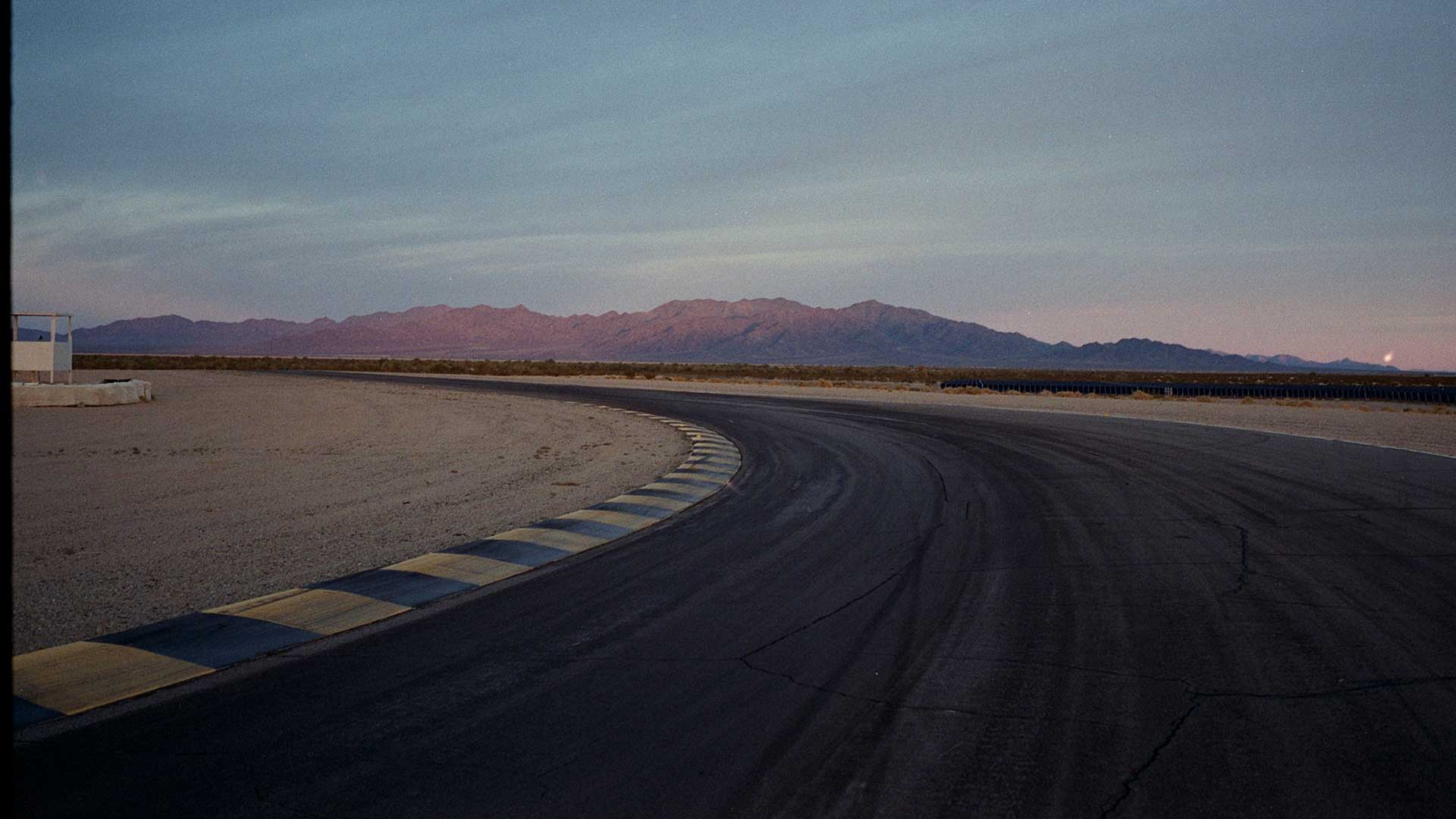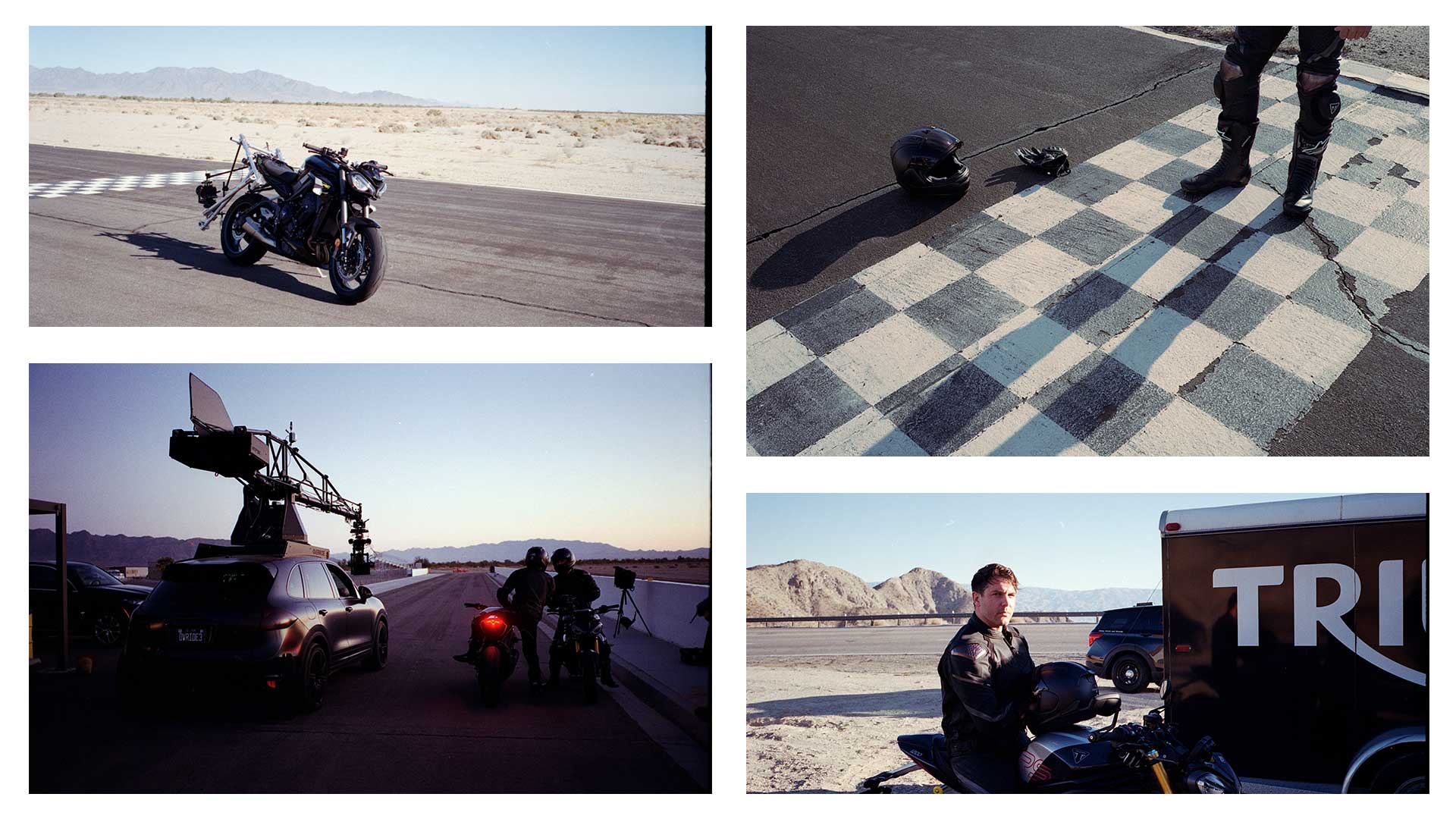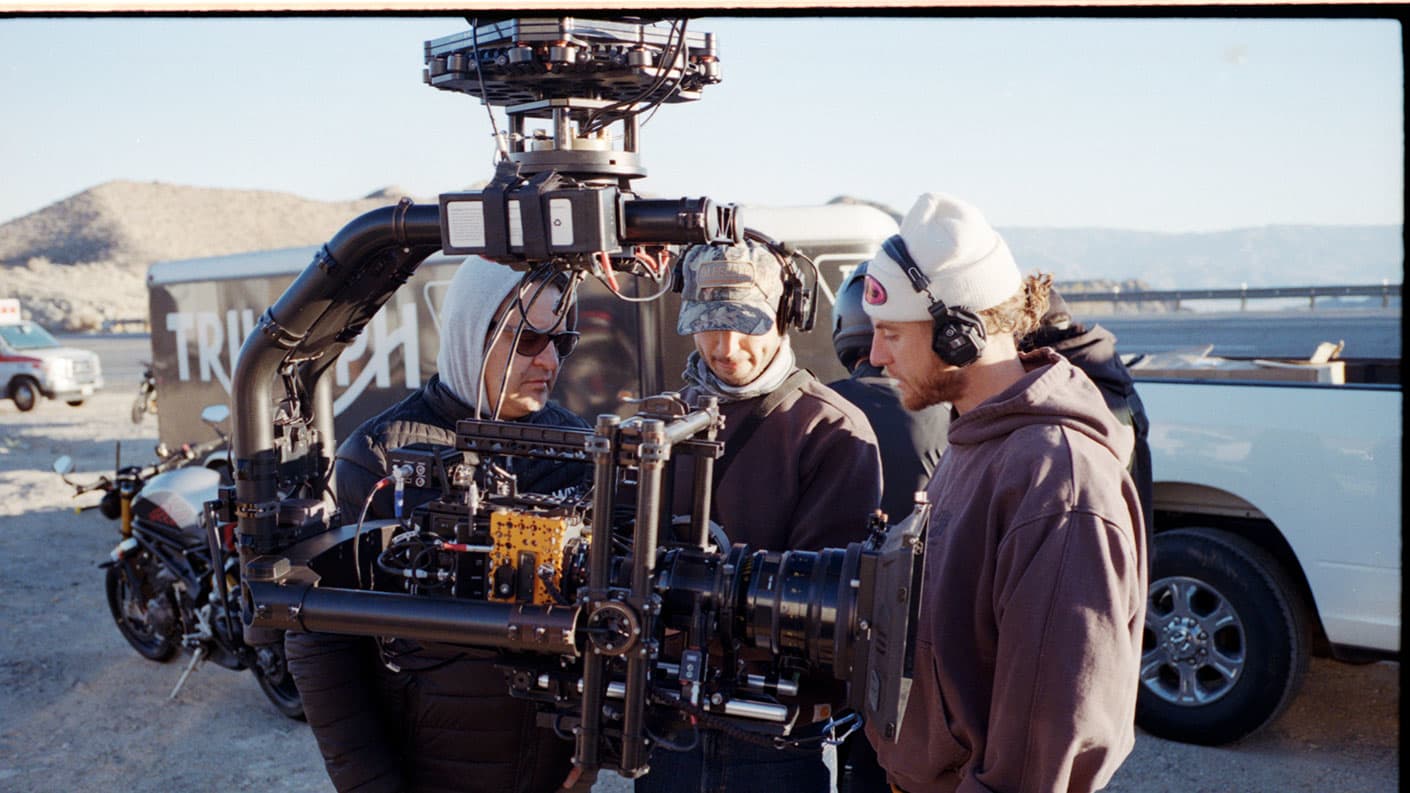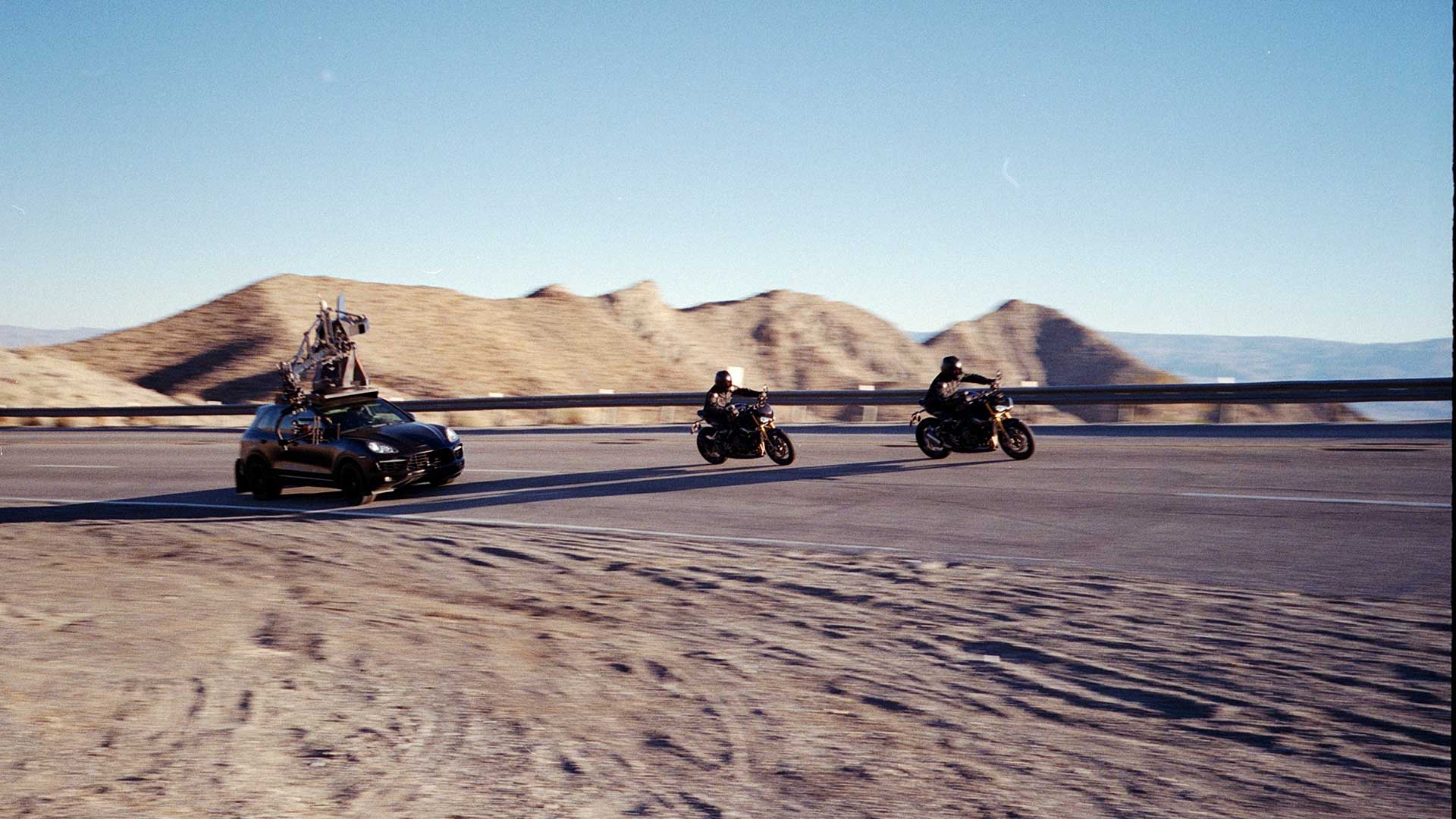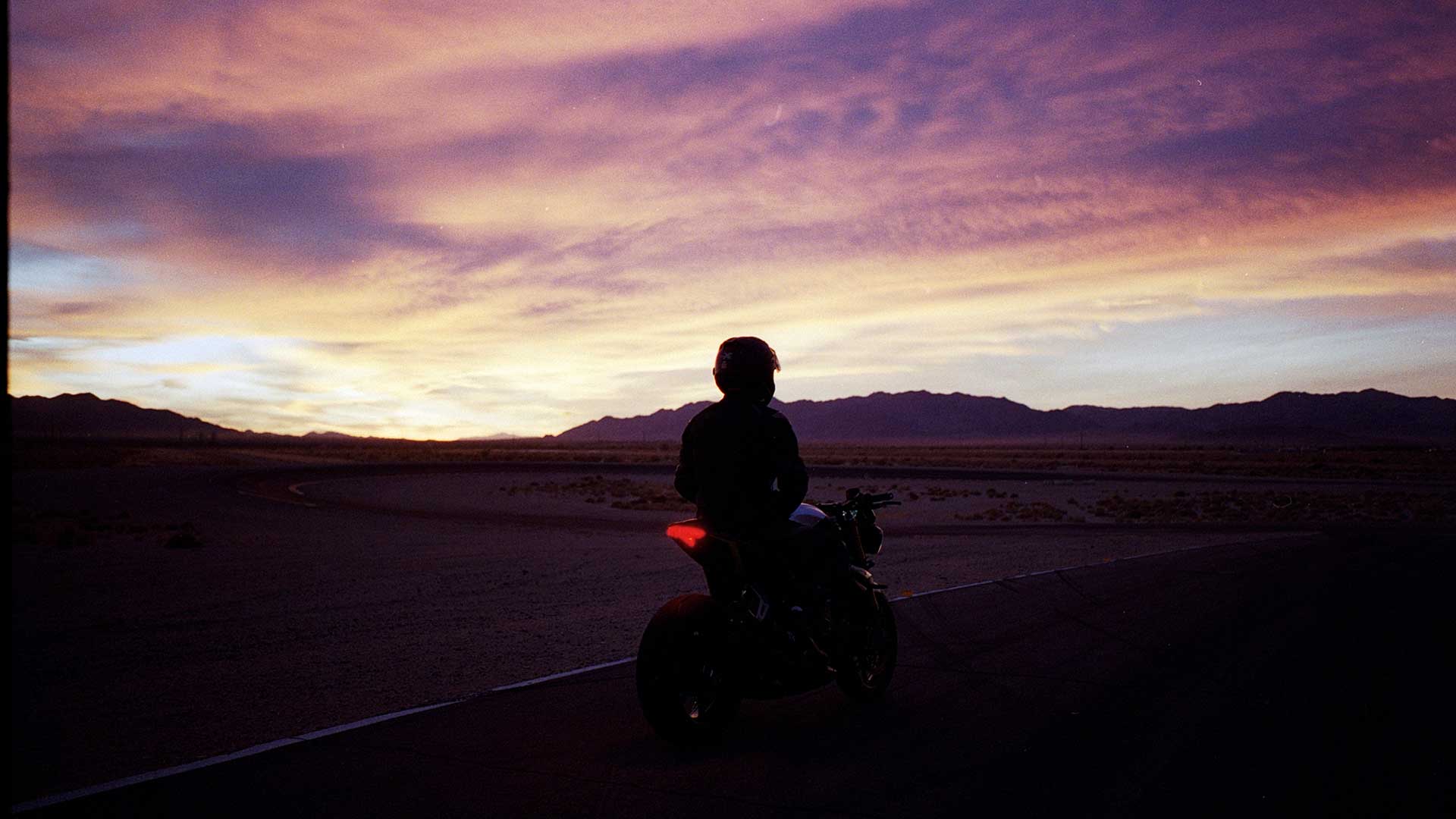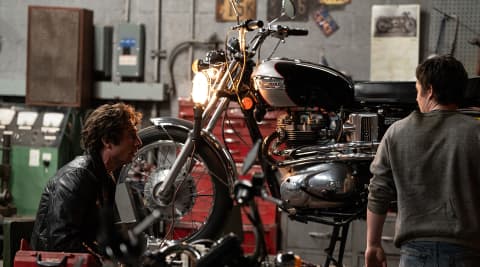CAPTURING THE SPEED
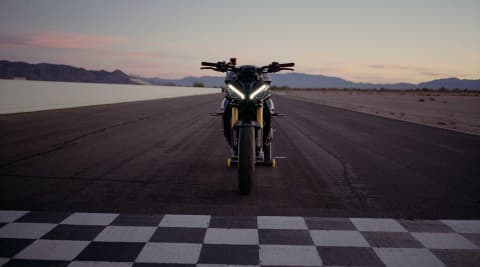
Triumph’s engineers went to extreme lengths in order to create the latest incarnation of the Speed Triple RS, so capturing what it’s like behind the bars of the iconic street fighter on video and for photos meant pushing production standards to a new level
Putting you behind the bars
A little over 5280 miles from Triumph’s Hinckley base, the stars are still shining in the skies above the Mojave desert. A cacophony of various phone alarms pierce the tranquility of the night, signalling a very, very early start.
In the glorious surroundings of the Chuckwalla Valley Raceway months of meticulous planning has assembled a crew who are the very best at what they do. Whether it’s the camera operator, photographer, precision rider, or arm car driver - this is a world class production team that continually pushes the boundaries.
The mission of the team here in the desert is to somehow capture the very essence of the new Speed Triple 1200 RS. The noise. The performance. The power. The Speed. The Triple. And they’ve just two days to film, photograph and record sound in order to really convey what it feels like to be the rider in the seat experiencing the heightened capabilities of this iconic machine.
Real time. Fake nothing.
You can’t fool motorcyclists. Riding a bike is a unique experience and, time and time again, we see Hollywood films failing to capture in any accurate way the visceral and unrivalled feeling that is riding a motorcycle. Capturing it requires a production team that really understands riding who are armed with the right equipment to get among the action.
A quick glance around reveals a high-speed camera car fitted with a ‘Russian Arm’, ultrafast first person view (FPV) drones being unpacked, and $40,000 cinematic cameras being set, all operated by a tight knit team. The bikes are being ridden by World Championship-level racers who are also highly experienced in movie stunts and vehicle action. All here to do justice to this twin-eyed, wide-barred icon.
“All the planning is there to make sure we can be as safe as possible at what is essentially a dangerous subject,” says director Nick Dean. “But to give the Speed Triple absolute justice needs a group of professionals working in sync, communicating almost telepathically even when working the most complex of shots happening at such high speeds in close proximity and all against the clock. I trust in this team.”
A diamond in the rough
Chuckwalla Valley Raceway in the Mojave desert was chosen for a reason. An exhilarating 2.68 mile assortment of seventeen tarmac twists and turns, it doesn’t scream for attention like the brightly-painted run-offs and advertising-strewn world championship circuits. If anything, it looks otherworldly.
“We picked the circuit carefully in order to really put the Speed Triple RS through its paces and to make sure the attention was always on the bike,” says director Nick Dean.
The extreme temperature differences of the desert is hard on a lot of things, including tarmac. Thankfully, the recently resurfaced circuit doesn’t weather the scars of beatings by the heat. Instead, its geographic position treats it to a fine peppering of sand on its surface, providing a dramatic effect in the shots.
“There was no point in trying to blow the sand off the track,” says Nick. “Besides, it added to the effect; just the riders and the ride. It’s like the riders just stumbled across the circuit. The viewer should be drawn to the power and pull of the Speed Triple”
Fishing for the perfect shot
The revs are high. The distinctive and evocative sound of two 1160cc three-cylinder engines dominate the surroundings. As the riders perform their well-rehearsed ballistic ballet, riding inches apart in complex choreographed cooperation, capturing the action is a camera car being precision driven a bike’s length away.
This is high stakes fishing. The camera car dangles its bait - tens of thousands of pounds worth of equipment hunted down by hungry Speed Triples. The action has to be fast: authentic, real, and raw - it can’t be faked. The black Porsche is no match for the two Triumphs, instead they real it in with ease - prey turned poacher. Even with the weight of the camera arm, the inside rear wheel is lifting on the car and the remaining tyres are squealing.
In the back seat, compressed together with each corner are three members of the crew viewing the chase in real time. Not for one second worried about the high speed chase they’re part of, but howling with excitement at what they’re witnessing on the monitor. They’re nailing this shoot and they know it.
“Dancing with bikes. Drawing with rubber.”
It’s an interesting analogy from stunt rider Kieran Clarke, a former professional superbike racer turned Hollywood stunt rider. “Whatever parallels you want to make. Being able to make art with motorbikes and unbelievably talented people is very special,” he says. “Ultimately we are trying to sell the legend that is the Speed Triple. The results of these projects don’t happen by chance; nothing is fluked and nothing is faked.”
Never a dull moment.
While the motion team prep for their next set of action sequences it’s the stills team’s turn. If you’ve ever wondered how those dynamic photos that show the front of a bike coming right at you are captured, it’s not for those who suffer with motion sickness…
Taking pictures of fast motorcycles isn’t easy at the best of times, even for the pros. So imagine having to do this while hanging out of the back of a truck that’s travelling at 50mph through turns as it's kicking up dust and spitting out fumes. And that’s exactly what photographer Jordan Pay is about to do, harnessed into a specially made platform mounted onto the flatbed of a Toyota TRD 4x4.
Though the harness prevents the risk of Jordan falling out, the cornering forces and roll of the car still make it a turbulent ride on the bed. The bikes and riders aren’t flustered at these speeds, it’s their proximity to the car that adds to the danger here. A steady (and firm) hand is needed on the camera while the other is used to conduct the bikes into position, inches from the lens.
Watching the truck pass by us with two bikes tucked right behind it, the whole set-up looks far from glamorous. But this is what it takes to get ‘the shot’, and the finished results are dynamic and stunning.
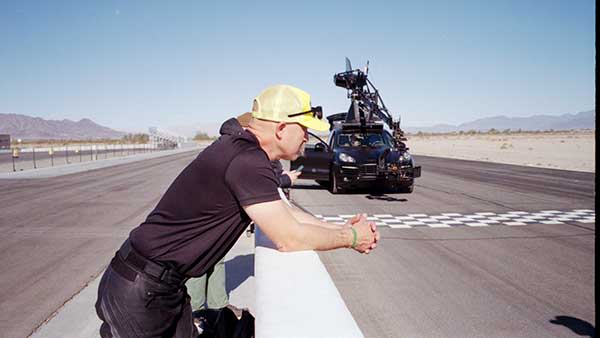

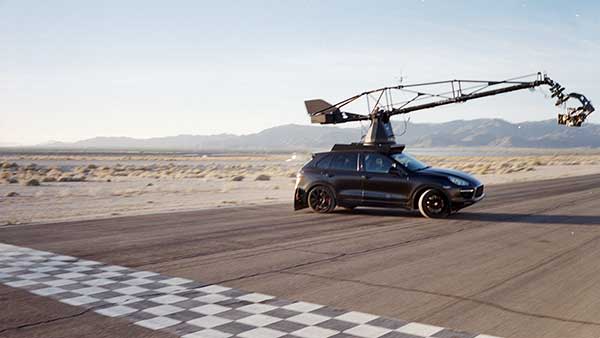
Don’t waste daylight.
Shoot days are long. Sunlight is never taken for granted. Every moment is scheduled so that bikes and track are always in use. Nobody wants to come back to base wishing they’d not used every single moment to grab that killer shot.
The riders assigned to the motion team talk over where they’ll be for the upcoming shot, using their hands to represent the bikes; it's like they’re talking in sign language and rehearsing the moves so it becomes instinct when cameras are rolling.
In the background Bobby the Grip is working on the set-up of a Street Triple as a camera bike. While the camera car is fast, nothing can truly keep up with a bike except another one. Stripped of its rear bodywork, being attached to its subframe is a huge rig that will mount a cinematic camera to produce action shots so dramatic the viewer feels like they’re riding along. Setting the angles and capturing the shots all the way around the circuit at high speed takes precision riding to another level, especially with the weight of the camera to factor in.
Sure, modern action cameras can be easily stuck on to deliver insane footage, but think about it in the same way major motion pictures and TV programmes aren’t shot with very capable smartphones. Saying that, the latter is being used here to capture action in a slightly different way for Triumph’s socials.
A 200mph game of chicken, anyone?
A counter shot, in stunt terms, is when vehicles are coming head-to-head at each other and the camera lifts before any contact takes place. It sounds simple, but to convey real intensity it can’t be filmed slowly and then sped up in post-production to produce the desired result.
In this case, two bikes will go head on with the camera car. Each travelling at 100mph. Not only that, the second bike will be tucked so close behind the first, its rider won’t be able to see what’s coming.
No matter the experience of the team, with a shot like this there’s always tension in the air. Riders and driver are in intense talks - working through the shot in conversation so there’s no doubt of who needs to be where and when. Comms are essential inside the helmets of the riders so the team can direct the riders with industry-standard language - there is no room for misinterpretation.
The imposing car, dangling its robotic arm with a video camera hand speeds towards the bikes as they in turn do likewise. Cutting through the fine layer of sand and seemingly on a collision course, the arm lifts at exactly the right moment, providing the riders with a clear path and resulting in a breathtaking capture of speed. By nailing it in the first take, there’s no need to reset and go again.
Only bikes give moments like these
A shot is required to give the point of view from the seat of the rider. Although the circuit, devoid of the furniture and colour of most modern tracks, was chosen as not to be a distraction from the star of the show, the 360-degree surrounding mountain range has provided a moving background throughout the days as it responds to the changing level and intensity of the sun.
As the day turns to dusk - the golden hour for those who like to take pictures - stunt rider Kieran explains what would be his favorite moment of the shoot.
“The camera was set up for laps on my own. So I’m on this incredible bike, with a track all to myself and there’s this ‘The Bowl’ turn. I’m certainly not cruising out there on the Speed Triple. Back-shifting hard into this positively cambered section, the auto blipper and slipper clutch is keeping the bike superbly composed. I’ve got my knee on the inside kerb for this double apex and the whole mountain range and the circuit is glowing orange with the setting sun. An unbelievable richness in colour, it looks fake. Such a surreal experience but so incredible and something that will stay with me forever. I didn’t want to be on any other bike at that moment.”
It’s a wrap
After two days of intense shooting and riding, the Speed Triples RSs, equipment and crew have been pushed to the limits. The bikes haven’t skipped a beat, and their capability has allowed the production team to achieve even more than they hoped.
Packing up the shoot, Nick studies the graze on the end of what is a very expensive camera lens after it hit the ground on one of the more adventurous shots. “It still works absolutely fine. And every time I see that scuff, I’ll think about this incredible shoot.”
But what of the production itself? Nick responds: “I’ve always been on a pursuit to translate the visceral feeling of speed. What it’s like to be one with the ride. ‘Visceral’ has been my mantra word. In anything action and commercial orientated, you obviously need to show the product - fly the camera around to show the bike. But we wanted to put the audience right in the seat, so lots of different shots were required and that produced a big shot list. Did we do a good job? We think so. But I guess those watching will be the judge of that.”

